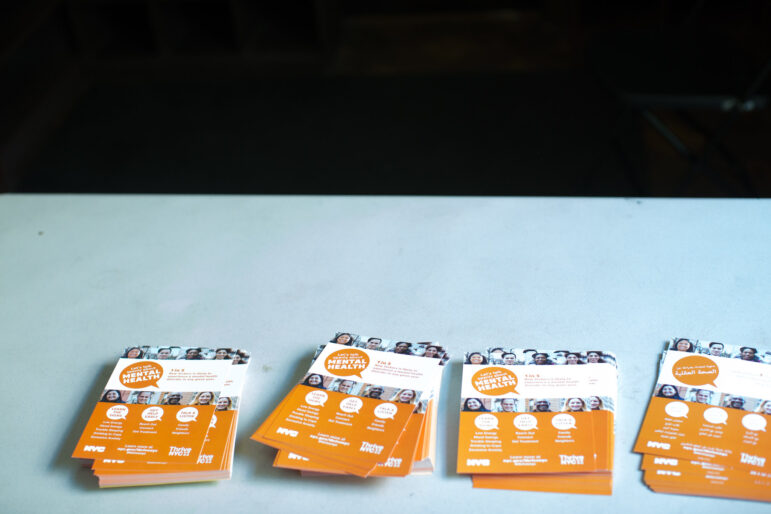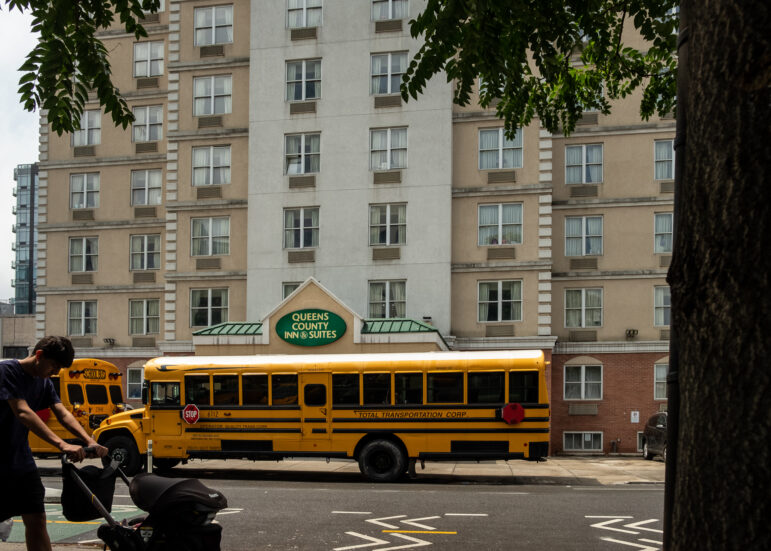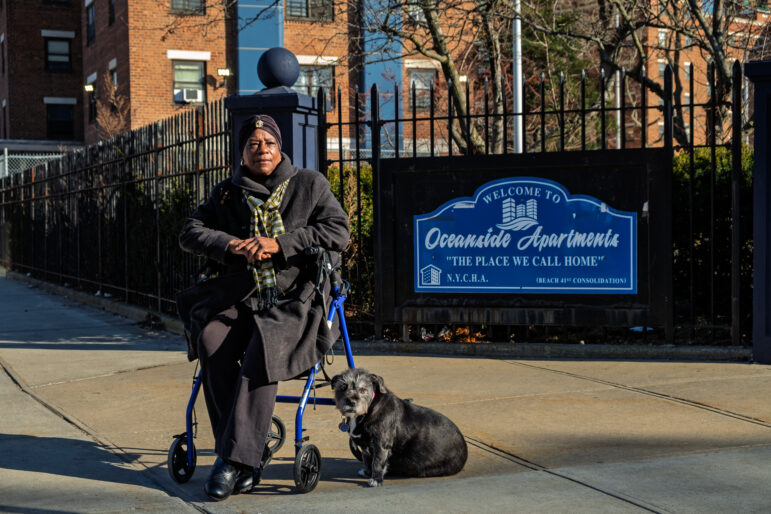Air pollution is an added stressor for vulnerable populations who already suffer disproportionately from underlying health effects, including the estimated thousands of unhoused New Yorkers living on the city’s streets, experts say.

Ed Reed/Mayoral Photography Office.
Mayor Eric Adams and administration officials at a briefing on the air quality emergency on Wednesday.
On Wednesday, as New York City’s air quality plummeted due to wildfire smoke drifting from Canada, Josiah Haken and his team at the homeless outreach organization City Relief prepared to distribute masks stockpiled during the coronavirus pandemic.
“We still have a decent supply of N95s, so we made the decision pretty quick,” Haken told City Limits. “It’s not new for us to give out masks, but today we tried to make an effort to not just offer them but encourage them.”
The organization conducted its usual outreach at Chelsea Park in Manhattan distributing meals, socks and hygiene products to homeless and low-income residents, in addition to masks and water bottles. But on Thursday, they decided to scale back weekly Sara D. Roosevelt Park distribution to masks and water, and direct people to the nearby Bowery Mission for an inside meal.
“Ironically with COVID we were trying to get people outdoors, now we’re trying to get them indoors,” Haken said.
At a Wednesday evening press conference, the message from Mayor Eric Adams was clear. “We’re encouraging New Yorkers to stay home, indoors, tonight and tomorrow whenever possible,” he said. “Especially our vulnerable New Yorkers.”
But this is easier said than done for the estimated thousands of unhoused New Yorkers living on the city’s streets. Air pollution is an added stressor for vulnerable populations who already suffer disproportionately from underlying health effects, said Dr. Vijay Limaye, senior climate and health scientist at the Natural Resources Defense Council (NRDC).
“It’s especially concerning in terms of the unhoused population to be thinking about people who are struggling to deal with pre-existing chronic conditions and then needing to confront exposure to the elements and outdoor air pollution over many hours or days this week,” he said.
A spokesman for the city’s Health + Hospitals system said late Wednesday that some local hospital emergency departments “have seen an uptick in patients with smoke-related respiratory symptoms,” but did not provide specifics.
Short-term exposure to air pollution can lead to coughing, throat irritation, eye irritation or swelling, headache, nausea and fatigue, according to Limaye, while long-term exposure can have more serious health effects.
Yet the very people with outsized vulnerability can be difficult to reach, particularly if they don’t have a cell phone, according to Garima Raheja, a PhD candidate at Columbia University’s Climate School and Lamont Doherty Earth Observatory, who researches the effect of air pollution on vulnerable populations.
“Having access to the internet can really expand access to advisories and public health messaging,” she said.
A spokesperson for the Department of Social Services (DSS) told City Limits Thursday that its homeless outreach teams, including city workers and contractors, are continuing to canvas across the city, distributing masks and water and helping people move indoors. So-called Street Medicine Teams have been directed to follow-up with people with known respiratory issues.
“During extreme conditions, our outreach teams redouble their efforts citywide, prioritizing their most vulnerable clients and offering shelter services and support to any New Yorkers experiencing unsheltered homelessness,” the agency said.
On Wednesday night, street outreach teams with Project Hospitality of Staten Island canvassed around the Staten Island Ferry Terminal with masks. Chief Executive Officer Terry Troia said that staff were directed to explain that there was a health emergency, and that people could come to a nearby drop-in center for relief from the smoke.
“We got some people who came and those that didn’t took the masks with gratitude,” she said by text message Thursday morning.
Brooklyn Council Member Lincoln Restler, who worked in intergovernmental affairs under prior Mayor Bill de Blasio, said the administration could go further, by initiating a “Code Red” historically implemented during extreme heat events.
During such an event, any person reasonably believed to be homeless can access shelter system-wide bypassing intake processes, and outreach teams work on tailored priority lists, urging people to come indoors.
“I am outraged that the DHS has not issued a Code Red alert,” Restler told City Limits. “We have clear practices in place for weather in public health emergencies that allow for all street homeless individuals to go into any shelter in New York City for their safety – when it’s really cold, really hot, or certainly too hazardous to breathe.”
DSS said it has doubled down on outreach and that in addition to drop-in centers in each borough, it operates specialized shelters known as Safe Haven and stabilization sites, which allow people to bypass the intake process required for larger congregate shelters. There were 3,100 Safe Haven and stabilization beds in New York City as of last month, according to a Coalition for the Homeless review of city data.
In a statement, the homeless advocacy organization said the air quality crisis is “another reason why the right to shelter is critical”—a reference to City Hall’s recent moves to suspend and weaken some of the city’s legal mandates for providing shelter.
“Having a place to go to get away from the smoke can be life-saving for our most vulnerable homeless neighbors, many of whom suffer from respiratory illnesses,” Coalition for the Homeless said in a tweet.
At a press briefing Thursday morning, Mayor Adams brushed off that criticism and defended the city’s response more generally. “Climate change is creating unpredictable weather patterns,” he said. “There are going to be uncertainties. We’re going to try to figure it out. We’re going to respond as they come.”
New York first issued an air quality advisory related to Canadian fires on Monday for large swaths of the state. The Air Quality Index (AQI), used by the U.S. Environmental Protection Agency to predict pollution based on levels of ozone or fine particulate matter in the air, reached a high of 413 on Wednesday afternoon for the New York City metro area—what officials consider “hazardous” for residents.

Michael Appleton/Mayoral Photography Office
Smoke from wide fires in Canada blurring the New York City skyline on Tuesday.The city’s AQI dropped to 209 as of Thursday morning, less dire than the day before but still deemed “very unhealthy” under the evaluation system.
NYC Emergency Management Commissioner Zach Iscol said offshore winds were expected to “move smoke back into the city” Thursday afternoon, but that conditions are likely to improve in the coming days.
“Things will progressively continue to get better through Tuesday, when we have a front moving through that should push everything out,” he said during a press briefing Thursday morning, but warned it was hard to predict. “Smoke modeling and pollution modeling is very, very hard to do.”
In the meantime, advocates were urging New Yorkers to look out for one another.
“If I was to give a piece of advice for someone walking to point A or point B and wants to help people who are homeless, carry masks or offer a bottle of water,” said Haken of City Relief.
On Wednesday, Gov. Kathy Hochul tweeted that New Yorkers can pick up N95 masks at state sites, including MTA stations and Port Authority. Several FDNY stations were also distributing masks. Restler, who represents District 33 in Brooklyn, identified local public spaces with good air quality Thursday, and tweeted out a list including a senior center and four libraries.
Limaye said he wouldn’t be surprised if we were to see more wildfire smoke hit New York in the coming months. It’s something to pay attention to, especially as the temperature rises throughout the summer. “Think of your prescriptions interacting in a way that’s dangerous. The same goes for heat and air pollution,” he said.
As the City plans for future climate disasters, he continued, it is going to have to think creatively about how to address the compounding effects of climate change and employ existing resources to support New Yorkers. One idea is to equip cooling centers for public use not just when the temperature rises, but also when outdoor air pollution spikes.
“[We need to] think more holistically about the range of threats, especially because the science is pretty clear that we’re going to be facing pretty converging crises in the years to come,” said Limaye.
With additional reporting by Jeanmarie Evelly.








